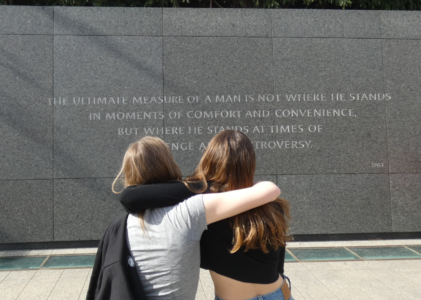Click here to listen to this week’s JAM: Can You Hear Me Now?
Middle School students traveling during Reach Beyond Week experienced many new and wonderful things, from tea ceremonies in Tokyo to learning about the inner workings of the Supreme Court. They also experienced what it was like to travel when all of us as adults were kids. How so? They didn’t have access to their phones.
That’s right. One of the rules during Reach Beyond Week trips is that we held onto student phones from the moment they landed at their location until the morning they were preparing to get back on a plane and return home. The only exception? Maybe one – or in some cases on international trips – two opportunities to call home during the trip.
The thinking was that students would be allowed to disconnect from their phones and from all the things that entails – posting to social media, playing games, streaming Netflix, Hulu, Amazon Prime, HBO Max, and multiple other sites, listening to music, podcasts, audiobooks. When we first announced it to students, there was surprise, some audible shocks, and a general sense of doom. The main question – How will we take photos? We reassured them we would bring cameras on the trip and have students share the responsibility for taking photos.
During the Washington, DC trip, I continually marveled at how differently students showed up. We had lots of down time – while riding the Metro, while waiting to get into various places, catching our breath after a long walking tour – and during each of these periods students hung out with each other, talking, laughing, sharing stories. Some students pulled out books – old fashioned, hold in your hands books – when they wanted some quiet time to themselves. The tour guide who spent the full week with us was surprised to hear that we didn’t have phones, and then continually noted how much more engaged and active our students were. Every other student group I saw had phones. The low point? A group of Middle School students from another school filming a TikTok video inside one of the museums.
While I thought the absence of phones was great, I was really curious to hear from students at the end of the week what they thought. The final morning – after they had their phones back in preparation for the return – I asked for input. What, if anything, had they missed? Several students noted that several times during the week they weren’t able to quickly Google something when they were out and about. Another student mentioned they missed the chance to take selfies, while another said that several times they realized they didn’t know the time – and had no easy way of finding out.
Anything else? Students were pretty quiet. Finally, one student said that she actually didn’t miss much. Not having a phone hadn’t been a huge deal. Others nodded their heads. Then she added, “I didn’t miss it because no one had it.” In other words, she went on, the main reason she felt pulled to be on her phone when at home is because everyone else was on their phone. She didn’t want to miss out on anything. Taking it away from all of them resolved FOMO.
Ultimately, I’m so glad that we made the decision to withhold phones, and I recognize that it does not simply translate into the reality of being back at home, in the real world. If nothing else, I hope we hold onto the opportunity during these trips – and other school experiences – to provide students with this gift, the gift of not needing to be tethered to their device for a week. And, in response to the old Verizon commercial – “Can you hear me now?” During RBW, at least, our students would have happily replied, “no, not right now, I’m hanging with my friends IRL.”

